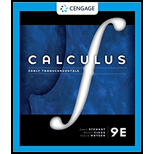
Calculus: Early Transcendentals, Loose-leaf Version, 9th
9th Edition
ISBN: 9780357022290
Author: Stewart
Publisher: Cengage Learning Acquisitions
expand_more
expand_more
format_list_bulleted
Question
Chapter D, Problem 78E
To determine
In triangle
Expert Solution & Answer
Want to see the full answer?
Check out a sample textbook solution
Students have asked these similar questions
Please focus on problem ii.
Please focus on problem x.
Please focus on vii.
Chapter D Solutions
Calculus: Early Transcendentals, Loose-leaf Version, 9th
Ch. D - Prob. 1ECh. D - Convert from degrees to radians. 2. 300Ch. D - Prob. 3ECh. D - Prob. 4ECh. D - Convert from degrees to radians. 5. 900Ch. D - Prob. 6ECh. D - Prob. 7ECh. D - Prob. 8ECh. D - Prob. 9ECh. D - Prob. 10E
Ch. D - Prob. 11ECh. D - Prob. 12ECh. D - Prob. 13ECh. D - Prob. 14ECh. D - A circle has radius 1.5 m. What angle is subtended...Ch. D - Find the radius of a circular sector with angle...Ch. D - Prob. 17ECh. D - Prob. 18ECh. D - Draw, in standard position, the angle whose...Ch. D - Prob. 20ECh. D - Prob. 21ECh. D - Prob. 22ECh. D - Find the exact trigonometric ratios for the angle...Ch. D - Prob. 24ECh. D - Prob. 25ECh. D - Find the exact trigonometric ratios for the angle...Ch. D - Prob. 27ECh. D - Prob. 28ECh. D - Prob. 29ECh. D - Prob. 30ECh. D - Prob. 31ECh. D - Find the remaining trigonometric ratios. 32....Ch. D - Prob. 33ECh. D - Prob. 34ECh. D - Prob. 35ECh. D - Prob. 36ECh. D - Prob. 37ECh. D - Prob. 38ECh. D - Prob. 39ECh. D - Prob. 40ECh. D - Prob. 41ECh. D - Prob. 42ECh. D - Prob. 43ECh. D - Prove the identity. 44. sin(x)=sinxCh. D - Prob. 45ECh. D - Prob. 46ECh. D - Prob. 47ECh. D - Prob. 48ECh. D - Prob. 49ECh. D - Prob. 50ECh. D - Prob. 51ECh. D - Prob. 52ECh. D - Prob. 53ECh. D - Prob. 54ECh. D - Prob. 55ECh. D - Prob. 56ECh. D - Prob. 57ECh. D - Prob. 58ECh. D - If sinx=13 and secy=54 , where x and y lie between...Ch. D - Prob. 60ECh. D - Prob. 61ECh. D - If sinx=13 and secy=54 , where x and y lie between...Ch. D - Prob. 63ECh. D - Prob. 64ECh. D - Prob. 65ECh. D - Prob. 66ECh. D - Find all values of x in the interval [0,2] that...Ch. D - Prob. 68ECh. D - Prob. 69ECh. D - Prob. 70ECh. D - Prob. 71ECh. D - Prob. 72ECh. D - Prob. 73ECh. D - Prob. 74ECh. D - Prob. 75ECh. D - Prob. 76ECh. D - Prob. 77ECh. D - Prob. 78ECh. D - Prob. 79ECh. D - Prob. 80ECh. D - Prob. 81ECh. D - Prob. 82ECh. D - Prob. 83ECh. D - Prob. 84ECh. D - Prob. 85ECh. D - Prob. 86ECh. D - Prob. 87ECh. D - Prob. 88E
Knowledge Booster
Learn more about
Need a deep-dive on the concept behind this application? Look no further. Learn more about this topic, calculus and related others by exploring similar questions and additional content below.Similar questions
- Please focus on ix.arrow_forwardPlease focus on vi.arrow_forward的 v If A is an n x n matrix that is not invertible, then A. rank(A) = n C. det(A) = 0 B. Reduced row-echelon form of A = In D. AB BA= In for some matrix B 63°F Partly sunny Q Search 3 $ 4 40 FS 96 S W E A S T FG S Y & コ B ㅁ F G H J 4 Z X C V B N M 9 H V FIB - FIB ㅁ P L ว DELETE BACHSPACE LOCK L ? PAUSE ALT CTRL ENTER 7 2:20 PM 4/14/2025 HOME J INSERT SHIFT END 5arrow_forward
- i Compute the given determinant by cofactor expansions. At each step, choose a row or columnthat involves the least amount of computation.7 6 8 40 0 0 68 7 9 30 4 0 5arrow_forwardi Compute the inverse of the matrix below using row operations. Please show your work.1 0 −2−3 1 42 −3 4 This is a 3*3 matrix. First row is 1 0 -2.arrow_forwardSolve the system of equations below by applying row operations on the corresponding aug-mented matrix to convert it to the reduced row-echelon form. Write the solutions using freevariables as parameters.x1 + 3x2 + x3 = 1−4x1 − 9x2 + 2x3 = −1−3x2 − 6x3 = −3arrow_forward
arrow_back_ios
SEE MORE QUESTIONS
arrow_forward_ios
Recommended textbooks for you
 Mathematics For Machine TechnologyAdvanced MathISBN:9781337798310Author:Peterson, John.Publisher:Cengage Learning,
Mathematics For Machine TechnologyAdvanced MathISBN:9781337798310Author:Peterson, John.Publisher:Cengage Learning, Holt Mcdougal Larson Pre-algebra: Student Edition...AlgebraISBN:9780547587776Author:HOLT MCDOUGALPublisher:HOLT MCDOUGAL
Holt Mcdougal Larson Pre-algebra: Student Edition...AlgebraISBN:9780547587776Author:HOLT MCDOUGALPublisher:HOLT MCDOUGAL Trigonometry (MindTap Course List)TrigonometryISBN:9781337278461Author:Ron LarsonPublisher:Cengage Learning
Trigonometry (MindTap Course List)TrigonometryISBN:9781337278461Author:Ron LarsonPublisher:Cengage Learning- Algebra & Trigonometry with Analytic GeometryAlgebraISBN:9781133382119Author:SwokowskiPublisher:Cengage
 Trigonometry (MindTap Course List)TrigonometryISBN:9781305652224Author:Charles P. McKeague, Mark D. TurnerPublisher:Cengage Learning
Trigonometry (MindTap Course List)TrigonometryISBN:9781305652224Author:Charles P. McKeague, Mark D. TurnerPublisher:Cengage Learning Elementary Geometry For College Students, 7eGeometryISBN:9781337614085Author:Alexander, Daniel C.; Koeberlein, Geralyn M.Publisher:Cengage,
Elementary Geometry For College Students, 7eGeometryISBN:9781337614085Author:Alexander, Daniel C.; Koeberlein, Geralyn M.Publisher:Cengage,

Mathematics For Machine Technology
Advanced Math
ISBN:9781337798310
Author:Peterson, John.
Publisher:Cengage Learning,

Holt Mcdougal Larson Pre-algebra: Student Edition...
Algebra
ISBN:9780547587776
Author:HOLT MCDOUGAL
Publisher:HOLT MCDOUGAL

Trigonometry (MindTap Course List)
Trigonometry
ISBN:9781337278461
Author:Ron Larson
Publisher:Cengage Learning

Algebra & Trigonometry with Analytic Geometry
Algebra
ISBN:9781133382119
Author:Swokowski
Publisher:Cengage

Trigonometry (MindTap Course List)
Trigonometry
ISBN:9781305652224
Author:Charles P. McKeague, Mark D. Turner
Publisher:Cengage Learning

Elementary Geometry For College Students, 7e
Geometry
ISBN:9781337614085
Author:Alexander, Daniel C.; Koeberlein, Geralyn M.
Publisher:Cengage,
How to apply the law of sines to find the remaining parts of a triangle; Author: Brian McLogan;https://www.youtube.com/watch?v=NdRF18HWkmE;License: Standard YouTube License, CC-BY